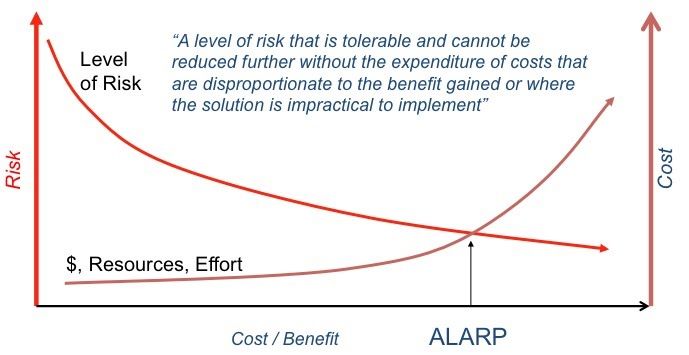The Use Of ALARP In Singapore

ALARP is the acronym for “as low as reasonably practicable”. ALARP originated from the British health and safety system. It stems from the concept “reasonably practicable” which involves weighing a risk against the trouble, time and money needed to control it. It is a pivotal part of the general duties of the Health and Safety at Work etc Act 1974. ALARP is a term commonly used by risk specialists and duty holders. It describes the level to which workplace risks should be controlled.
Using ALARP to measure risk can be quite challenging because duty holders are required to exercised their professional judgment. In high hazards, complex or novel situations, to achieve ALARP in judgment, decisions have to be built on existing good practices, formal decision making techniques, and cost-benefit analysis.

Image credit: http://www.jakeman.com.au/media/alarp-as-low-as-reasonably-practicable
Here are a few characteristics of ALARP:
- It takes significant analysis to determine how to get into ALARP range
- There is a need for organisation to implement risk management benchmarking or performance measurement to tell if risk management is heading towards or away from ALARP.
- ALARP is all about trade-offs. There is no perfect ‘ALARP’.
In Singapore, all MHIs (Major Hazard Installation) are required to develop its Safety Case, and demonstrate the case to MHD (Major Hazard Department) that their strategy for managing safety is satisfactory through ALARP principle.
This strategy is presented in a set of documents that include:-
- Hazard Identification Process
- Identification of hazards with the potential to cause major accidents
- Evaluation of major accident risks
- System/procedures that will be put in place to control them
- Measures to limit major accident consequences
- ALARP methodology
Refer to article on the Safety Case Regime in Singapore: http://www.opuskinetic.com/2017/08/31/safety-case-regime-in-singapore/
ALARP Principles & Guidelines is a 2-day course designed to covers the important principles of ALARP, discusses the variability of ALARP requirements for managing the same hazards in different circumstances and the application of risk targets. From this course, participants can look at the various approaches to assess risks from the qualitative methods to quantitative methods. Participants will also get the chance to learn how to apply ALARP concept in different situations and processes, e.g. design, specifying instrumented safety systems, operating procedures, etc. For more information, please visit us at http://www.opuskinetic.com/training or contact us at info@opuskinetic.com
Opus Kinetic believes that people are why organisations are successful, and giving people the knowledge to perform well at their job is integral for success. We pride ourselves as the premier provider of knowledge, offering acclaimed in-house training, leadership training courses, oil and gas training courses, courses that target health safety and environment, etc. Our training courses are well researched and updated with the latest industry trends. For more information on our professional training programs, you can visit us at http://www.opuskinetic.com/training.

